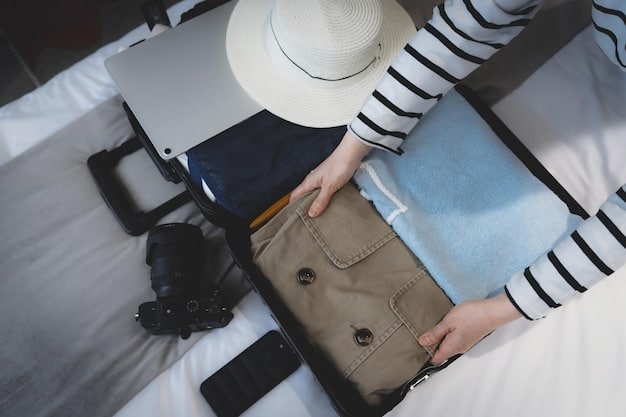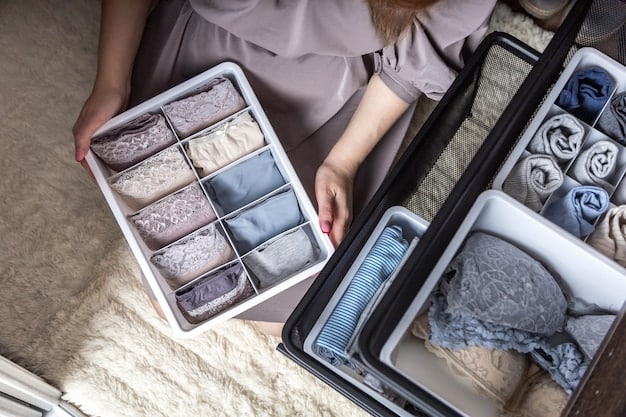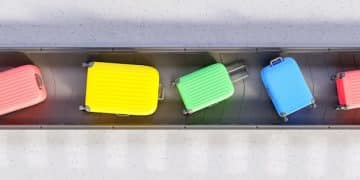Master the Art of Packing: Your 7-Day Smart Travel Challenge

Mastering the art of packing is essential for any traveler, enabling lighter luggage, smarter choices, and a more enjoyable journey; our 7-day challenge offers a structured approach to transform your packing habits, ensuring efficiency and confidence for every trip.
Embarking on a journey, whether for business or leisure, often brings with it the universal dilemma of packing. The desire to carry everything one might possibly need often collides with the practical realities of luggage limits, airline fees, and the sheer burden of heavy bags. This challenging balance is precisely what our guide aims to address, helping you Master the Art of Packing: Learn to Travel Lighter and Smarter with Our 7-Day Challenge.
The Fundamentals of Smart Packing: Beyond the Basics
Understanding the fundamental principles of smart packing is the initial step toward transforming a typically stressful task into an efficient art form. It transcends simply fitting items into a bag; it involves a strategic mindset focusing on need versus want, versatility, and the efficient use of space. This approach not only lightens your load but also streamlines your travel experience from check-in to arrival.
A common misconception is that smart packing means sacrificing comfort or preparedness. On the contrary, it’s about optimizing what you bring, ensuring each item serves a purpose or multiple purposes. This foresight prevents overpacking for hypothetical situations and underpacking for essential ones.
Understanding Your Travel Needs
Before any item touches your suitcase, a thorough assessment of your travel needs is crucial. This involves considering several key factors that dictate what should accompany you on your journey. Understanding these elements can significantly narrow down your packing list.
- Destination Climate: Research the weather patterns and typical temperatures for your destination during your travel dates.
- Activities Planned: List all the activities you anticipate engaging in, from formal dinners to adventurous hikes.
- Duration of Stay: The length of your trip directly influences the quantity of clothing and toiletries needed.
This preliminary analysis serves as a filter, helping you decide on the types of clothing, footwear, and accessories that are genuinely necessary. It encourages a proactive approach, moving beyond impulsive packing based on what you “might” wear.
Smart packing also emphasizes the importance of minimalist principles. This doesn’t necessarily mean traveling with only a backpack, but rather adopting a philosophy where every item earns its place. It often involves selecting versatile pieces that can be mixed and matched to create multiple outfits, thereby reducing redundancy.
Day 1: Declutter and Digitize Essentials
The first day of our packing challenge focuses on purging unnecessary items and leveraging technology to reduce physical bulk. This initial decluttering phase is pivotal, setting the tone for a lighter and more organized travel experience. It forces a critical look at what you truly need versus what you habitually bring.
Many travelers cling to the “just in case” mentality, leading to suitcases filled with unused items. Day 1 encourages breaking this habit by challenging every item’s right to occupy precious travel space. It’s about mental preparation as much as physical sorting.
The Digital Transformation
In an increasingly digital world, a significant amount of traditional travel clutter can be eliminated through digitization. This includes critical documents, entertainment, and reading material. Embrace your smartphone, tablet, or e-reader as a multifunctional travel tool.
- Boarding Passes & Tickets: Use mobile passes stored in your phone’s wallet app.
- Identification & Documents: Scan passports, visas, and reservations, storing them securely in cloud storage or a password-protected app.
- Books & Magazines: Replace physical copies with digital versions on an e-reader or tablet.
By digitizing, you not only reduce weight but also ensure duplicates of important information are always accessible, even if physical copies are lost or inaccessible. This step alone can alleviate a significant portion of travel anxiety.
Beyond documents, consider how much entertainment you consume on the go. Entire libraries of books, countless hours of music, and even movies can be stored on a single device. This eliminates the need for bulky books, CDs, or DVDs, making travel lighter and more streamlined.
Day 2: The Art of the Capsule Wardrobe
Day 2 delves into the concept of the capsule wardrobe, a revolutionary approach to clothing selection for travel. This strategy emphasizes versatility, coordination, and minimizing the number of distinct clothing items you pack. It’s about creating a cohesive collection of garments that can be mixed and matched to form various outfits suitable for different occasions and weather conditions.
Building a capsule wardrobe for travel begins with selecting a core color palette, often neutrals like black, grey, navy, or beige, which serve as foundational colors. Complementary accent colors can then be introduced through accessories or a few key pieces. This systematic approach ensures everything works together, maximizing your outfit options from a minimal selection.
Selecting Versatile Pieces
Identify clothes that can serve multiple purposes or be styled in different ways. For instance, a versatile pair of dark jeans can transition from a casual daytime look to an evening outfit with a change of top and accessories. Similarly, a lightweight cardigan can provide warmth or serve as a stylish layer.
- Layering: Choose items that can be layered easily to adapt to temperature changes, such as lightweight sweaters, camisoles, and scarves.
- Multi-occasion Wear: Select garments that are appropriate for both casual and slightly more formal settings.
- Wrinkle Resistance: Prioritize fabrics that are less prone to wrinkling, reducing the need for ironing and keeping you looking polished.
The essence of a travel capsule wardrobe is not to limit your fashion expression but to enhance it through smart choices, ensuring you always have appropriate attire without overpacking. It simplifies decision-making, both during packing and throughout your trip.
By day’s end, your focus should be on a curated selection of clothes, significantly less than what you might traditionally pack, yet offering more versatility. This deliberate choice frees up luggage space and eases the burden of hauling excessive baggage.
Day 3: Optimize Toiletries and Meds
On Day 3, attention shifts to personal care items: toiletries and medications. These categories are notorious for adding unexpected weight and bulk to luggage, often due to full-sized containers or unnecessary quantities. The goal is to streamline these essentials, adhering to airline regulations and personal needs without compromise.
The “travel-sized” section in stores exists for a reason, but savvy travelers go beyond simply buying smaller bottles. They consider their actual consumption patterns and potential accessibility of items at their destination, distinguishing between truly essential and merely convenient.

Smart Strategies for Toiletries
To optimize your toiletry bag, think miniatures, solids, and multi-purpose products. Liquid restrictions for carry-on luggage (the 3-1-1 rule for US domestic flights) make this particularly important for those wanting to avoid checked bags.
- Travel-sized Containers: Decant your preferred shampoos, conditioners, and lotions into reusable travel-sized bottles. This reduces waste and ensures you only bring what you need for the duration of your trip.
- Solid Alternatives: Consider solid shampoo bars, conditioner bars, and soap bars. These eliminate leakage risks and count as non-liquids.
- Multi-purpose Products: Choose items that serve dual purposes, such as a tinted moisturizer with SPF or a shampoo that also works as a body wash.
For medications, always carry essential prescriptions in their original, labeled containers, along with a copy of your prescription or a doctor’s note, especially for international travel. Over-the-counter medications can be brought in smaller quantities, sufficient for the trip’s duration, rather than entire bottles.
Finally, consider what you can purchase at your destination. Basic toiletries like toothpaste or standard lotions are often readily available, eliminating the need to pack them. This approach requires a slight shift in mindset, trusting in local availability for non-critical items.
Day 4: Tech & Gadget Essentials
Day 4 focuses on consolidating technology and gadgets, a category that can quickly overwhelm a travel bag with cables, chargers, and various devices. The objective is to bring only what is truly necessary for communication, productivity, and entertainment, while minimizing bulk and ensuring compatibility.
In our hyper-connected world, resistance to unplugging might be high, but smart packing for tech means making deliberate choices. It’s about identifying the core functions you need access to, rather than bringing every device you own.
Streamlining Your Digital Kit
A common pitfall is packing multiple devices that perform similar functions. Evaluating your needs and selecting one multi-functional device can significantly reduce your tech footprint.
- Multi-port Charger: Invest in a single USB wall charger with multiple ports to charge several devices simultaneously, reducing the number of individual power bricks.
- Universal Adapters: For international travel, a universal travel adapter is indispensable, negating the need for multiple country-specific adapters.
- Portable Power Bank: A reliable power bank ensures your essential devices stay charged on the go, especially when outlets are scarce.
Consider the cumulative weight and space consumed by various cables. Often, a few versatile cables (e.g., USB-C, micro-USB, lightning) can service most of your devices. Cable organizers can prevent tangles and make them easier to find.
Lastly, question each gadget’s necessity. Do you really need a separate e-reader if your tablet or smartphone serves the purpose? Is a laptop essential, or can a tablet with a keyboard cover suffice for light work? These questions guide you towards a more minimalist tech travel approach.
Day 5: Master Packing Techniques
With your curated items ready, Day 5 is dedicated to the physical act of packing. This is where theory meets practice, focusing on techniques that maximize space, minimize wrinkles, and organize content efficiently. The method you choose can profoundly impact the volume of your luggage and the condition of your belongings upon arrival.
There isn’t a single “best” packing method, as effectiveness often depends on the type of luggage, the items being packed, and personal preference. However, understanding various techniques allows for an informed choice specific to your travel needs.

Rolling vs. Folding vs. Compression
These are the three primary techniques for organizing clothes within a suitcase, each with distinct advantages:
- Rolling: Often cited as the most space-saving method, rolling clothes tightly can also reduce wrinkles in many fabrics. It works particularly well for softer garments like t-shirts, jeans, and casual dresses.
- Folding: Traditional folding is suitable for more structured garments that might crease with rolling, such as blazers, crisp shirts, or delicate items. It’s often combined with flat packing methods.
- Compression Packs: These bags, either vacuum-sealed or zip-compressed, remove air from clothes, drastically reducing their volume. While excellent for space, they can make your bag heavier and may cause more wrinkles.
Beyond clothes, consider how you pack shoes and accessories. Place shoes in individual bags to protect clothing from dirt, and fill the shoes themselves with smaller items like socks or chargers. Jewelry and delicate accessories should be secured in small pouches or cases within your personal item.
Ultimately, the key is to experiment with these methods and find a combination that works best for your specific items and luggage shape. The goal is a tightly packed, stable bag where items are easily accessible without disrupting the entire contents.
Day 6: The Personal Item and Accessibility
Day 6 shifts focus to the personal item, an often underutilized asset in the quest for lighter, smarter travel. This bag (e.g., a backpack, tote, or large purse) is typically allowed in addition to a carry-on and holds items you’ll need access to during your journey, rather than at your final destination. Strategic packing of this item is key for comfort and convenience.
The personal item becomes your in-flight survival kit, your mobile office, or your entertainment hub. Its contents should reflect immediate needs, ensuring a smooth and productive travel experience without constant retrieval from overhead bins.
What Belongs in Your Personal Item?
Prioritize essentials in your personal bag that you might need at a moment’s notice or during transit. This includes items for comfort, security, communication, and immediate personal care.
- Important Documents: Passport, boarding pass, ID, wallet, and any other critical papers.
- Medications: Any prescription medications you absolutely cannot be without, in case your main luggage is delayed.
- Electronics: Laptop, tablet, phone, and their respective chargers/power bank.
- Comfort Items: Neck pillow, eye mask, noise-cancelling headphones, and a light wrap or sweater.
- Personal Care: Small hand sanitizer, lip balm, and perhaps a travel-sized toothbrush and toothpaste.
Consider a change of underwear and a spare top, especially on longer flights, as a contingency for lost luggage or unexpected delays. This single addition can significantly alleviate stress. Also, pack a reusable water bottle (empty, to fill after security) to stay hydrated.
Ensuring easy access to these items means organizing your personal bag thoughtfully. Use small pouches or compartments to separate categories like electronics, toiletries, and documents, making them simple to retrieve without creating a rummaging mess.
Day 7: The Final Review and Mindset Shift
On the final day of our challenge, it’s time for a comprehensive review of your packing efforts and, more importantly, a solidified mindset shift towards future travel. This day is about fine-tuning, learning from the process, and committing to these lighter, smarter habits. The aim is to move beyond temporary compliance to an ingrained approach to travel preparation.
This concluding phase reinforces the idea that smart packing is not a rigid set of rules but a flexible framework that adapts to each unique journey. It’s about cultivating confidence in your choices and trusting that you’ve packed thoughtfully and efficiently.
The 24-Hour Rule and Future Planning
Before sealing your luggage, step away from your packed bags for at least 24 hours if possible. Then, return with fresh eyes to conduct a final audit. This “24-hour rule” often reveals items that can still be removed without impacting your trip negatively.
- Re-evaluate “Just in Case” Items: Challenge any item you questioned during the initial decluttering phase. If it hasn’t served a clear purpose, leave it out.
- Weigh Your Bag: If checking luggage, ensure it’s within airline weight limits to avoid unexpected fees. For carry-on, test its portability.
- Test Accessibility: Simulate accessing items you’ll need during transit (e.g., passport, phone, water bottle) to ensure they are easily reachable.
Reflect on your travel experiences. What did you genuinely use on past trips? What remained untouched? Use these insights to refine your packing list continually. Maintaining a master packing list that you adjust for each trip can also be incredibly beneficial, saving time and ensuring consistency.
Ultimately, Day 7 is about embracing a new philosophy of travel—one where freedom comes from carrying less, and peace of mind comes from knowing you have exactly what you need. This challenge isn’t just about packing for this trip; it’s about transforming how you approach all future adventures, making them lighter, smarter, and more enjoyable.
| Key Principle | Brief Description |
|---|---|
| 📚 Declutter & Digitize | Reduce physical items by digitizing documents and entertainment. |
| 👗 Capsule Wardrobe | Pack versatile, mix-and-match clothing to maximize outfit options. |
| 🧴 Optimize Toiletries | Use travel-sized or solid products to save space and avoid leaks. |
| 🧩 Master Techniques | Employ rolling, folding, or compression to efficiently fit items. |
Frequently Asked Questions
The “3-1-1 rule” applies to liquids, aerosols, gels, creams, and pastes in your carry-on luggage. Each container must be 3.4 ounces (100 milliliters) or less, fit in one 1-quart-sized (liter-sized) bag, and be limited to one bag per passenger. This rule primarily aims to enhance security screening processes at airports.
A capsule wardrobe streamlines packing by curating a small collection of versatile clothing items that mix and match effortlessly. This approach reduces the number of items you need to pack while maximizing your outfit options. It focuses on timeless pieces in a cohesive color palette, promoting efficiency and style.
Yes, packing cubes are highly recommended for organizing your luggage. They help compartmentalize your belongings, compress clothing slightly, and make it easier to locate specific items without disturbing your entire suitcase. While they don’t reduce the weight of your luggage, they significantly enhance organization and space utilization.
The most crucial item to pack in your personal bag is generally your passport and any essential travel documents, followed closely by necessary medications. These are items you cannot afford to lose or be without, especially during transit or if your checked luggage is delayed. Having them immediately accessible ensures peace of mind.
To minimize wrinkles, consider rolling softer garments, carefully folding more structured items, and layering delicate pieces with tissue paper. Opting for wrinkle-resistant fabrics like knits, synthetics, or blends also helps considerably. Using packing cubes can further prevent shifting, which often leads to creasing during transit.
Conclusion
The journey to mastering the art of packing is a continuous learning process, but one that yields substantial rewards for every traveler. By embracing the principles outlined in this 7-day challenge—from meticulous decluttering and strategic digitization to optimizing personal care items, streamlining technology, and employing efficient packing techniques—you are not just preparing for a trip; you are cultivating a smarter, more mindful approach to travel itself. This transformation ensures that your focus remains on the experience ahead, unburdened by excessive luggage or disorganization, truly allowing you to travel lighter and smarter, every time.





